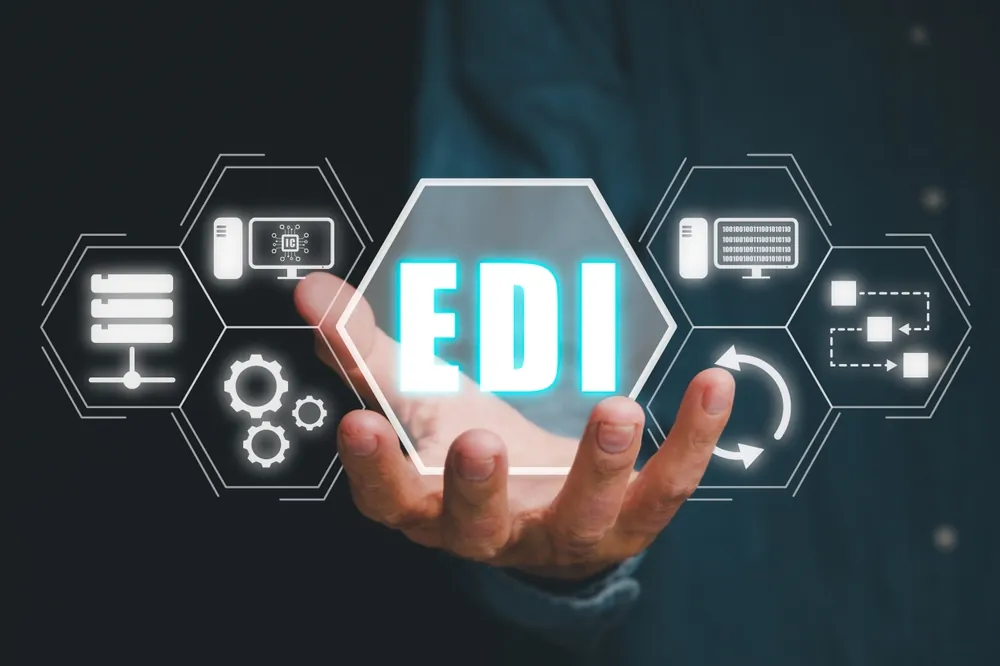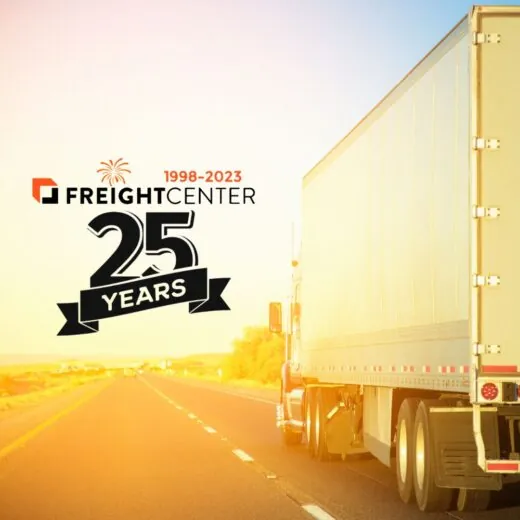
Understanding EDI
We’ve helped thousands of businesses and individuals all over the world get their goods from point A to point B faster and smarter.
What is EDI?
Electronic Data Interchange is an electronic interchange of business information utilizing a standardized format. The process allows companies to send information to one another electronically, forgoing a physical document exchange. Using the power of EDI means replacing mail handling and preparation and standardizing information communicated within business documents to create a “paperless” exchange.
The traditional document exchange process takes three to five days; in contrast, the document purchase order exchange usually occurs overnight and can take less than an hour! It replaces document exchange methods, including postal mail, fax, and email. The two companies exchanging business documents with one another are called “trading partners” or “business partners.”
Most commonly exchanged documents include purchase orders, invoices, advance ship notices, bills of lading, customs, inventory, shipping status, and payment documents. Transitioning your business from paper-based exchanges to electronic creates many benefits, including reduced costs, increased processing speed, reduced errors, and improved business partner relationships.
Development
This technological concept began to develop in the late 1960s and early 1970s. One of the earliest examples of its application traces back to the transportation industry in the late 1960s. The US transportation sector faced challenges handling large volumes of paper-based documentation in business transactions. In 1968, the Transportation Data Coordination Committee (TDCC) was established, which initiated the development of transportation sector electronic standards.
It has become a key technology for several industries, such as automotive, manufacturing, retail, and healthcare. Walmart, Home Depot, and Sears have been significant adopters of the technology. Each industry has its own implementation recommendations for the standards it requires. X12 is the predominant standard in the US, with EDIFACT being the predominant standard in Europe.
How does EDI work?
EDI documents require a standard format since computers, instead of humans, process them. A standard format is needed so the computers can read and understand the documents. Luckily, many standards are in use today, including ANSI, EDIFACT, TRADACOMS, and ebXML, each with its version. When two businesses exchange documents via EDI, they must agree on the specific standards and versions. It is common for companies to use a translator, either via in-house software or a service provider, to help make the translating and processing straightforward and seamless.
EDI utilizes a software application or an externally managed service to instantly transmit business documents between computers within minutes in a standard format. The first step for a transaction is creating an electronic document using information from your business data. Business data includes business systems, workbooks, and similar operations. These business documents have standardized forms, also known as transaction codes, to help expedite intake and utilization among businesses.
Typical Process:
- Buyer creates a purchase order for their product but does not print it.
- EDI generates an electronic version of the purchase order and communicates with the supplier.
- The supplier’s order entry system database updates upon receiving the purchase order.
- On the supplier side, their system creates and dispatches an acknowledgment confirming the receipt.
Essentially, an EDI solution maps and translates the data provided by supply chain partners. Partners include suppliers, merchants, or transporters that users can process. If your company already has EDI integrated into the system, data can be delivered automatically to your ERP system. Electronic data exchange is critical because it allows businesses to meet compliance standards for distributors and retailers. This exchange makes it easy for providers to meet customer requirements and expectations, streamline communication, and increase efficiency. This software ensures business documents are converted into an accurate format.
During a transaction, information flows between computers. And contains the following components.
Transactions include:
Data Elements: Includes distinct qualities such as the firm name, product code, and price. Standards compromise specs for each data element.
Segments: Segments are logically related data set components, including order number, volume, number of units, or price linked with the purchase order. Segment IDs precede segments, indicating the material or information components of the segment.
Envelopes: Envelopes encapsulate transaction sets for transmission.
We provide competitive freight shipping prices and an all-inclusive, easy-to-use shipping experience for our customers. Exceeding our customers’ expectations results in thousands of satisfied customer reviews and repeat business. We believe in the power of our customer relationships. Check out FreightCenter reviews from real customers, and learn what they have to say about their freight shipping experience!
Awards and Endorsements
- 2021 Food Logistics’ Top Green Providers
- 2021, 2017 & 2016 Food Logistics’ Top Green Providers
- 2021 & 2018 Supply & Demand Chain Executives’ Pros to Know: Matthew Brosious
- 2020 & 2019 Top Food Logistics’ 3PL & Cold Storage Provider Award
- 2020 & 2019 Business Observer’s Top 500 Companies on the Gulf Coast
- 2020 & 2017 SmartWay® Transport Partner
- 2020 & 2017 Food Logistics’ Champions: Rock Stars of the Supply Chain
- 2020 Best of Palm Harbor Awards for Local Businesses
- 2017 Green Supply Chain Award from Supply & Demand Chain Executive
- 2017 Tampa Bay Business Journal Heroes at Work
- 2016, 2015, & 2012 Food Logistics Top 100 Software and Technology Providers
- 2013 Top 100 Great Supply Chain Partners by SupplyChainBrain
- 2012 TIA Samaritan Award Honorable Mention
- 2012, 2011 & 2010 TBBJ Fast 50 Recipient
- 2013, 2011, & 2010 Diversity Business Top Businesses

Why Choose FreightCenter?
Why Choose Us For A Freight Quote?
- Shipping Quotes anytime
- Get Freight Shipping Quotes to anywhere in the U.S. & Canada.
- Unbeatable discounts on your freight LTL, truckload, rail, air, and more
- Automated Freight tracking, paperwork & invoices
- Manage all quotes & shipments in one place
- 24+ years of logistics experience working for you!
Choosing Your Carrier
There is no requirement to use the official carrier, and you stand to save a lot of money when you use a 3PL like FreightCenter to book your freight shipping. What’s more, when you call FreightCenter to take care of your shipping, you’ll receive excellent service for a fraction of the cost. The key is competition; FreightCenter is where top carriers compete for your business. Want proof?
Use our instant freight quote tool to receive estimates from numerous carriers, or speak to one of our freight shipping experts by calling us at 800.716.7608.
Choosing FreightCenter
When you choose to work with us, you are choosing to make your shipping process seamless. Here are just some of the benefits working with our Third Party Logistics company will have on your shipping experience:
- When you partner with FreightCenter, a premier 3PL (Third Party Logistics) company with over twenty-four years of experience within the logistics industry, you are choosing success. Over the decades, our team has dealt with nearly every shipment imaginable. There is no shipment process we cannot help you with!
- FreightCenter employs a knowledgeable staff always willing to learn and grow with industry changes and advancements. We are ready to answer any questions you have throughout the entire process!
- We act as the middleman between you and your carrier; you do not have to worry about playing phone tag with your trucker. Your agent will directly communicate with you and your carrier, delivering any necessary information or updates between you.
- We secure the best transit carrier and route for you at the best price. There is no need to spend hours figuring out the logistics or searching for a worthwhile deal.
- We make it easy to ensure your shipments by guiding you toward the best providers. Whether you need full or partial coverage, we have you covered!
- We arrange the pickups and drop-offs while also making sure to track each shipment in transit. This ensures that you know where your packages are every step of the way!
Now, what are you waiting for? Call FreightCenter to set up your account and discuss your shipment. We are ready to answer your questions and provide solutions! Our team looks forward to partnering with you.
Implementation and Requirements
Important factors to keep in mind:
- Data Transformation
- Batch Support
- Routing transactions
- Adhering to trading partner agreements (TPAs)
When implementing and establishing infrastructure, it is essential to keep the factors above in mind and obtain software that takes fields such as names and addresses in the file and can transfer to standardized documents, batch envelopes, and de-envelopes software and has message routing software. These critical capabilities allow senders and receivers to receive, wrap, and unwrap transactions. They enable them to send and deliver to the correct addresses and ensure message format compatibility.
Ensuring your EDI has all the components listed above usually involves setting up and connecting to VANs creating safe transfer pathways. Ensure you have the required hardware, network equipment, storage, and servers. Adhering to standards is also crucial in the implementation process. Your EDI system must adhere to your industry standards and protection regulations.
It is essential also to pay attention to any updates in standards and ensure compliance. Pay attention to any updates from your trading partners and be aware of changes to accommodate them. Lastly, establish connections by configuring your programming to use the same standards as your trading partners. This includes setting up firewalls, VPNs, or AS2 connections to ensure secure pathways.
Prioritize clear communication with your partners and understand and agree on document types, secure transmission methods, and requisite hardware and software. Communication and implementation should also consider translation and mapping software, batch enveloping and de-enveloping capabilities, message routing mechanisms, and trade partner agreements.
Benefits
EDI mitigates the inevitable issues with the human processing of business documents. The speed at which people and EDI can process documents without error is incomparable. No matter how intelligent or efficient, people slow down processing and are prone to mistakes. It is critical for B2B exchanges and processes and is preferred among businesses for document transfer and transaction processing.
EDI helps to conserve time and money through automation. The technology increases efficiency and output. Businesses can process documents more quickly with greater accuracy and remarkable precision. The strict standardization required by EDI minimizes mistakes and ensures data is appropriately structured. EDI connects electronic documents to IT systems for data gathering, analysis, and transparency. This technology helps to facilitate traceability and reporting. It’s transparency, traceability, and efficiency help drive positive customer experiences through dependable service.
Challenges
EDI has helped change the game in B2B transactions and exchanges. While this technology comes with a variety of benefits, EDI still has occasional challenges. Government regulations are prone to shifting its standards and updates. This can make it difficult for certain enterprises to keep up with and continuously implement new rules, changes, and updates. Enterprises need to keep up with changes in government standards and accommodate the complex needs and changes of global businesses.
And with technology as snazzy as EDI, you probably guessed it would be a significant business investment. Implementation requires investing in the hardware, software, and systems that align with regulatory requirements. Consider the costs of hiring a third-party network provider when considering the total implementation costs. Not to mention, there is much to learn when implementing EDI, and your employees will need the proper training, especially to get the most out of your investment. Training should cover processes, standards, software, and approaches. Additional training and resources have associated costs but are worth the investment.
Other challenges include effective document mapping, scaling, and ongoing monitoring. If your business uses multiple systems, this will require you to test your data mapping extensively to help ensure accuracy, which can be time-consuming and complex. Scaling is another challenge for EDI implementation. It requires adaptation to the EDI readiness and availability of all business vendors and logistics partners. Depending on the partner, there may be different rules, elements, and document fields that must be accounted for and accommodated.
Lastly, ongoing monitoring may present a challenge in implementation. Continual monitoring prevents disruptions, data quality reduction, and noncompliance situations. Resources should be allocated for audits, security assessments, and performance reviews.
To create value for our customers by delivering customized shipping solutions that meet their unique needs and to fulfill shipping demands from simple to complex with expertise, guidance and ingenuity.
Rely on the professionals at FreightCenter for competitive rates and a wide range of choices to meet your LTL freight shipping requirements.
We provide tailored solutions for both full and partial truckloads, offering competitive pricing for dry van, flatbed, and refrigerated freight. Trust us to meet all your full truckload shipping requirements.
Our Nationwide Expedited Trucking services ensure the secure and swift movement of your freight. Whether it's a single large box or a full truckload, our freight shipping experts are equipped to deliver your shipment quickly.
Access the most dependable rates for Specialized Freight Services from leading carriers with just a few simple steps. Whether you need white glove service or international shipping, we have your needs covered.
Utilize flatbed trucks to accommodate and transport oversized or uniquely shaped shipments with ease and efficiency. These specialized vehicles offer the versatility needed to securely and safely transport cargo that exceeds standard dimensions or has unconventional shapes.
Optimize your shipping strategy by integrating various transportation modes, including trucking and rail, to enhance efficiency and achieve cost-effectiveness.
Utilize rail transport for extended distances or when handling multiple packages during the shipping process.
Transport goods in containers aboard cargo ships for international shipping.
Opt for air transportation when time-sensitive delivery shipments is required.
Arrange for trucking services to transport packages across international borders.
Engage specialized heavy haul trucking services for oversized or cumbersome shipments.
A third-party logistics provider is a company that offers enhanced and cost-efficient supply chain and logistics solutions to other businesses.

FAQS
Q. Do different standards of EDI affect interoperability?
When trading partners use different versions of standards, interoperability can be challenging. Ensure systems can handle different versions to avoid compatibility problems down the line.
Q. How does AS2 secure EDI communication?
AS2 provides a standardized way to encrypt and digitally sign data to ensure secure partner communication.
Q. How do companies deal with EDI mapping for non-standard document formats?
Companies can use EDI mapping tools that assist in translating non-standard data formats into standardized formats.
Q. Can EDI be used for real-time data exchange?
Traditional EDI systems commonly use batch processing, but recent advancements have enabled real-time data exchange.
Q. Which industries are using EDI commonplace?
EDI is used in various industries like manufacturing, retail, healthcare, finance, and logistics. EDI is useful in industries that experience high volumes of transactions and complex supply chains.
Q. What are the critical components of an EDI system?
EDI systems usually include document formatting standards, communication protocols, and translation software.

